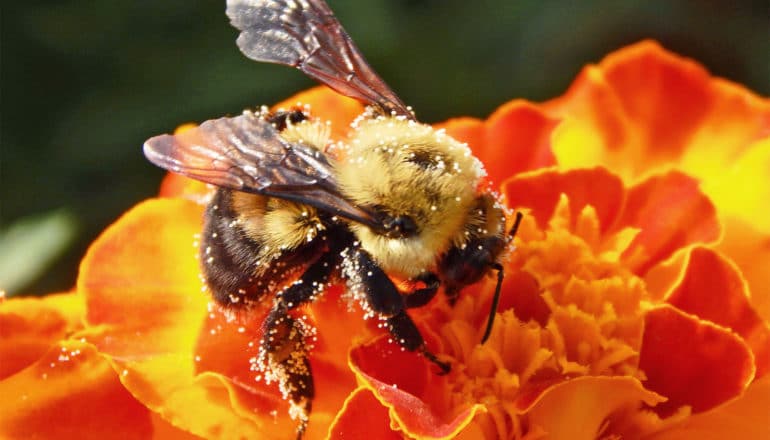
Bumble bees found in low-quality landscapes—with a relative lack of spring flowers and quality nesting habitat—had higher levels of disease pathogens, according to new research.
The researchers also found the same was the case for bumble bees in areas with higher numbers of managed honey bee hives.
The results of the study, which examined how a variety of environmental and landscape characteristics influence infectious disease prevalence and bee health, can be used to inform management practices to support the conservation of bee species that provide essential pollination services in natural and agricultural ecosystems, the researchers say.
“Recent worldwide declines in wild and managed bee populations have been attributed to several factors,” says lead author, DJ McNeil, postdoctoral fellow in the Insect Biodiversity Center in Penn State’s College of Agricultural Sciences. “For example, extensive habitat loss and degradation has led to a lack of flowers and nest sites, which in turn has contributed to the loss of wild bee abundance and diversity.”
He pointed out that more recently, some bee losses—especially among honey bees and bumble bees—have been blamed on rising levels of novel bee pathogens, perhaps exacerbated by other factors that weaken bee immunity or resistance.
“Many of the factors known to undermine bee health, such as poor nutrition or exposure to pesticides, can increase susceptibility to disease,” McNeil says. “Bees are more likely to be nutritionally deprived in landscapes with fewer and less diverse flowering plants, and poor nutrition can reduce the immune response and increase pathogen and parasite loads.”
The composition of bee communities also likely influences the incidence and loads of a particular pathogen or parasite in bee populations, notes coauthor Heather Hines, associate professor of biology and entomology. She explains that the incidence of viruses and parasites in wild bumble bees was higher in the presence of honey bee colonies, which often harbor higher loads of pathogens that are transmissible to native bees.
“Given all these interacting factors, disease prevalence and virulence can be challenging to predict in wild bee populations,” Hines says. “Our study is among the first to use data from a large geographic scale to evaluate the relative role of landscape features on the distribution and loads of key pathogens and parasites in wild bees.”
To measure pathogen loads, the researchers analyzed specimens of the common eastern bumble bee—Bombus impatiens, the most abundant bumble bee species in the region. The team collected bumble bee workers from sites across Pennsylvania during peak bumble bee abundance from late June to mid-July in 2018 and 2019. These sites, which included 38 of Pennsylvania’s 67 counties, were selected to represent evenly the span of the state and to include a diversity of habitat types and land use patterns.
The researchers then screened for three pathogens known to infect bees—deformed wing virus; black queen cell virus; and Vairimorpha, a microsporidian parasite—as well as for expression of a gene that regulates immunity. Using statistical analysis techniques, they correlated pathogen presence and loads with several recognized landscape-scale stressors, such as floral abundance, nesting habitat quality, insecticide loading, climatic conditions, and interactions with managed honey bees.
Their findings suggest that bumble bees collected within low-quality landscapes exhibited the highest pathogen loads, with spring floral resources and nesting habitat availability serving as the main drivers. The study also found higher loads of bumble bee pathogens where honey bee apiaries are more abundant, as well as a positive relationship between Vairimorpha loads and rainfall, and differences in pathogens by geographic region.
McNeil says results of the study highlight the need to maintain and create high-quality landscapes, such as those with abundant floral and nesting resources, to support healthy wild bee populations. The findings also draw particular focus to the value of spring floral resources, which often are less emphasized in pollinator garden plantings than mid-summer forage.
“Our results suggest that it may be possible to predict potential risks from pathogens and parasites based on these landscape indices, which can help inform decisions as to where habitat restoration and conservation practices should be applied,” he says. “This is particularly timely in light of widespread population declines in many insect groups, especially pollinators like bumble bees.”
The researchers hope to incorporate this information into Beescape, an online tool that allows people across the United States to evaluate their landscape quality. They encourage Pennsylvania homeowners, growers, and conservationists to read the Pennsylvania Pollinator Protection Plan, which contains a chapter on best practices for creating forage and habitat for bees in urban, agricultural, and natural landscapes.
The research appears in Scientific Reports. Additional researchers who contributed to the work are from Penn State; Dickinson College; and Pasture Systems and Watershed Management Research Unit, Agricultural Research Service, US Department of Agriculture.
The Foundation for Food and Agricultural Research supported this work.
Source: Penn State
The post Bumble bees in places with fewer flowers are sicker appeared first on Futurity.
from Futurity https://ift.tt/3pSR4wA
No comments:
Post a Comment